Shakespeare can be difficult to understand, but the actors of the Drama Department’s fall show, “The Comedy of Errors,” made following the play’s plot easy. Every line, movement and design element of the play, whose last show was Oct. 9, was bold and engaging. The modern setting also made for a more intriguing performance.
The set alone was beautiful and fun. It elicited awed looks from audience members as they entered the theater. Lights and banners extended above both the stage and audience, a unifying element which strengthened the actor-audience relationship inherent in Shakespeare productions. Despite this, the set was fairly minimalistic, which the cast utilized to its fullest potential. The scene changes involved the actors and were integrated into the performance. Design choices such as these succeeded due to the cast’s dedication to the show and their ability to stay completely in character at all times.
“[The show]’s really become ingrained in us,” ensemble member Sofia Lamrissi-Garcia, a fourth-year College student, said. “I feel like my character, even though I’m extra, that now I’m a crooked cop and I really enjoy that.”
Even if viewers started off a bit confused, the conflict and humor became more evident as the show went on. The production was impressively cohesive. Actors did an excellent job annunciating, making clear gestures and genuinely having fun with the performance. The misunderstandings between characters accelerated and the action built until an explosion of uproarious chaos at the end.
The decision to cast one actor as the central Antipholus twins (Drew McCarter) and one actor as the Dromio twins (Julian Sanchez) was a very successful choice. It greatly enhanced the farcicality of the production.
“The end is absurd and ridiculously fun switching back and forth,” McCarter, a second-year College student, said.
The final scene included fighting, arrests, beatings, escapes and total upheaval over who said or did what. The pair of twins must ultimately address one another, so McCarter and Sanchez literally jumped from one spot to the next in order to execute the dialogue with nothing more than a hat change or jacket donned or shed. The audience was laughing at the edge of their seats the entire time. It was difficult to keep up at times, but a bit of confusion in this scene was completely warranted and only added to the humor.
No aspect of the show was neglected. The stage space was full of side action embedded within the main scenes. Ensemble members conducted drug deals, sold goods, partook in theft, helped with scene changes and generally filtered on and off the stage, bolstering the volume of the space.
“It was really fun and we were laughing throughout the whole production of it, and the directors were really emphasizing that if we have fun, then the audience will have fun,” Lamrissi-Garcia said.
If this was a goal of the show, then it definitely succeeded. The show highlighted the necessity of play and not taking life too seriously. This especially came through in the final minutes of the performance when every actor put on a big, red clown nose.





